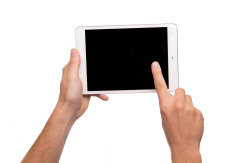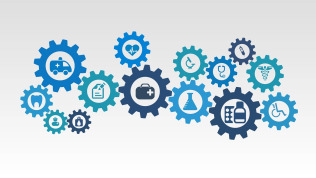 This week marks National Nurses Week in the U.S., both a celebration of the profession and an opportunity to educate the public about the role nurses play in healthcare and their communities. This year’s theme of “Nurses: Inspire, Innovate, Influence” highlights three concepts that overlap and reflect the innate role nurses play in patient care, as well as drawing attention to the personality types often drawn to nursing.
This week marks National Nurses Week in the U.S., both a celebration of the profession and an opportunity to educate the public about the role nurses play in healthcare and their communities. This year’s theme of “Nurses: Inspire, Innovate, Influence” highlights three concepts that overlap and reflect the innate role nurses play in patient care, as well as drawing attention to the personality types often drawn to nursing.
Tag Archives: workflow
Three Ways Technology Can Address Healthcare’s Growing Pains
 Science and medicine continue to advance at an astonishing rate thanks to technological innovation. We have already seen digital health solutions that promise to transform patient care in our lifetime. While these advancements are indeed groundbreaking for the healthcare industry, there are still basic day-to-day care processes in hospitals across the country ripe for improvement by applying technology.
Science and medicine continue to advance at an astonishing rate thanks to technological innovation. We have already seen digital health solutions that promise to transform patient care in our lifetime. While these advancements are indeed groundbreaking for the healthcare industry, there are still basic day-to-day care processes in hospitals across the country ripe for improvement by applying technology.
Nurse-Physician Collaboration: Harnessing the Power of Health IT to Improve Patient Outcomes
 Most physicians have long enjoyed the benefits of Bring Your Own Device (BYOD) policies. As health systems focused on ensuring doctors had access to state-of-the-art health IT to monitor their patients when they couldn’t be at the bedside, the quality of tools and pace of adoption for nursing solutions did not keep up. In some situations, nurses received bulky phones that could only be used within the walls of the hospital, while physicians needed to download specific apps on their own devices to receive calls from the nurses’ devices. Technical difficulties were frequent. In other situations, health systems tried rolling out solutions to nurses that had been used successfully by physicians. Unfortunately, those solutions were not always conducive to nurses’ workflow.
Most physicians have long enjoyed the benefits of Bring Your Own Device (BYOD) policies. As health systems focused on ensuring doctors had access to state-of-the-art health IT to monitor their patients when they couldn’t be at the bedside, the quality of tools and pace of adoption for nursing solutions did not keep up. In some situations, nurses received bulky phones that could only be used within the walls of the hospital, while physicians needed to download specific apps on their own devices to receive calls from the nurses’ devices. Technical difficulties were frequent. In other situations, health systems tried rolling out solutions to nurses that had been used successfully by physicians. Unfortunately, those solutions were not always conducive to nurses’ workflow.
Reflecting on IT’s Transformation of Healthcare
 As we celebrate National Health IT Week, it is incredible to realize how health technology tools are transforming every facet of patient care. From telehealth, to 3D printers to artificial intelligence, the explosion of personalized health devices redefines the dynamics of patient treatment and interactions.
As we celebrate National Health IT Week, it is incredible to realize how health technology tools are transforming every facet of patient care. From telehealth, to 3D printers to artificial intelligence, the explosion of personalized health devices redefines the dynamics of patient treatment and interactions.
However, we still fall short in comparison to other industries, particularly in terms of consistent patient information access, and the lack of incentive for industry collaboration to achieve smooth, interoperable data transfers. This week, we strike a balance between applauding our progress, yet refusing to rest on our laurels.
Patient-centric Approaches to Data are Great…Except When They’re Not
 In a variety of recent private and panel discussions with health and policy leaders, I’ve heard encouraging talk around interoperability through open and available application programming interfaces (APIs). Public comments by Health and Human Services Secretary Sylvia Mathews Burwell and Centers for Medicare and Medicaid Acting Administrator Andy Slavitt indicate there is sincere commitment to making this a reality.
In a variety of recent private and panel discussions with health and policy leaders, I’ve heard encouraging talk around interoperability through open and available application programming interfaces (APIs). Public comments by Health and Human Services Secretary Sylvia Mathews Burwell and Centers for Medicare and Medicaid Acting Administrator Andy Slavitt indicate there is sincere commitment to making this a reality.
While this momentum seems promising, when Meaningful Use Stage 3 is mentioned – particularly its requirements for making data available to patient facing applications – I see the potential for unintended and terrible consequences for clinician workflows.
Innovating at the Intersection of IT and Care
 Breaking down the silos between data sources and departments involves a complex blend of technology and people that, not surprisingly, can result in conflict along the way. However, the ultimate goal remains the same for all: protect the patient. Understanding the concerns of each department and encouraging communication amongst the groups can reduce this tension, allowing for innovation to take hold and enhance care throughout an organization.
Breaking down the silos between data sources and departments involves a complex blend of technology and people that, not surprisingly, can result in conflict along the way. However, the ultimate goal remains the same for all: protect the patient. Understanding the concerns of each department and encouraging communication amongst the groups can reduce this tension, allowing for innovation to take hold and enhance care throughout an organization.
Navigating the Sea of Innovation: Targeting the Right Audience with the Right Tools
 We are currently at a crossroads in the healthcare industry. Executives are working overtime to try to figure out how to connect and integrate data to best support clinical practice and patient care management. With health systems concerned about balancing both needs, they now need to figure out how to leverage data to get the best value out of their investment. Improvement and innovation in technology are slowly but surely enhancing the industry, but health systems are constantly being assaulted with software companies trying to sell them something. Thus, healthcare executives are left with the eternal question: Which pieces fit together best to create value and improve patient care?
We are currently at a crossroads in the healthcare industry. Executives are working overtime to try to figure out how to connect and integrate data to best support clinical practice and patient care management. With health systems concerned about balancing both needs, they now need to figure out how to leverage data to get the best value out of their investment. Improvement and innovation in technology are slowly but surely enhancing the industry, but health systems are constantly being assaulted with software companies trying to sell them something. Thus, healthcare executives are left with the eternal question: Which pieces fit together best to create value and improve patient care?
Healthcare in South Africa – Two Systems, Common Challenges
When it comes to mHealth, most industrialised nations such as the U.S. and Europe have a head start. Money for healthcare technology investments is available, the infrastructure is in place, and most of the population is already engaged in the healthcare system.
As a country of about 52 million people, South Africa shares many characteristics with its larger brethren. There is a mix of public and private healthcare providers and health insurance plans, physician shortages in key areas, and South Africa is beset by many of the same chronic diseases that industrialised countries face (cardiovascular and obesity-related diseases, diabetes, etc.).
Today’s Pressure Breeds Tomorrow’s Solutions
It is no secret that health systems are under intense pressure to deliver better outcomes at lower costs, and standardizing acute care workflow will only carry providers so far. Truly moving the needle on cost and outcomes will require a fundamental redesign in care delivery; otherwise, health systems may well find themselves left out. Care keeps shifting to environments in which hospitals have less influence: what was once critical care can now be managed in an in-patient unit; what was once in the hospital is now in an office; what was once in the office is now at home.
Creating a Friendly Environment for Adoption of Clinical Decision Support
In recent years, our ability to stream large amounts of data in real-time has improved dramatically. This enhancement can transform how clinicians offer care by sourcing unprecedented opportunities for clinical decision support. However, the capability to process, store, and display data in and of itself does not transform care. Rather, it is how the clinicians adopt and apply decision support that will make all the difference to patients. However, the current environment must be altered to create a clinical decision support-friendly climate.
